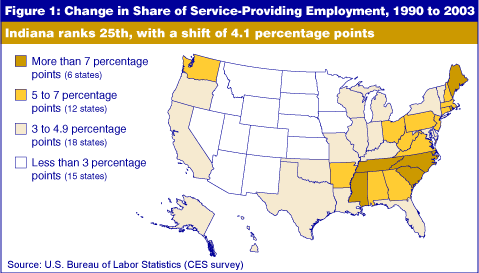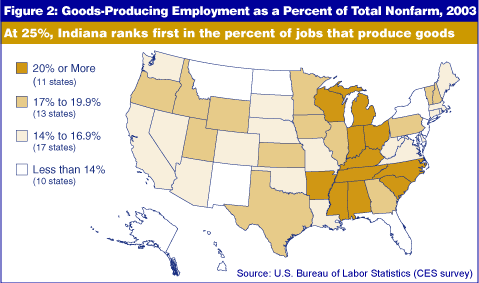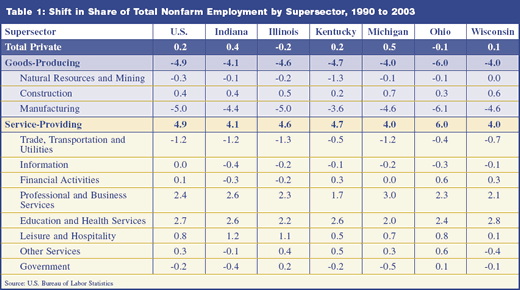The Changing Employment Landscape
The only constant is change. This adage certainly applies to both our economy and the mix of industry jobs. Over the last six decades, the composition of the workforce has shifted toward service-providing with a corresponding shift away from goods-producing employment. What is the extent of this shift? That can be quantified by using Current Employment Statistics (CES) data produced by the U.S. Bureau of Labor Statistics (BLS) and the Indiana Department of Workforce Development (see sidebar: Background on the Data).
The Shift: Gradual and Persistent
According to average annual national employment reported in the reconstructed NAICS series, goods-producing employment as a percent of total nonfarm employment peaked at 44 percent in 1943, a time when our country was busily engaged in efforts related to World War II. By 1990, however, that figure had dropped to 21.7 percent, or just under half of the 1943 percentage. The shift continued and by 2003 the figure had decreased to 16.8 percent. Stated in equivalent terms, service-providing employment increased from a low of 56 percent in 1943 to a high of 83.2 percent by 2003.
At the state level, NAICS series data for average annual goods-producing and service-providing employment are only available from 1990. The values represented in Figure 1 are simply the difference between the 1990 and 2003 share of service-providing employment within each state. That is, they are percentage point increases rather than percent increases. This is an important distinction to make, as it is possible to have an increase in share, even if service-providing employment decreases. In fact, that happened in the District of Columbia. By the same reasoning, there could be a decrease in share over the period, even when an increase in service-providing employment is observed. That actually happened in North Dakota.

How does Indiana compare to all other states and the District of Columbia on this measure? We fall in the middle of the pack, ranking 25th with a shift of 4.1 percentage points. North Carolina had the greatest shift at 10.4 percentage points, about 1.7 percentage points ahead of second place Rhode Island. North Dakota is the only state that had a decrease in share of service-providing employment, ranking last with a shift of -1.6 percentage points.
The Midwest Has the Goods
Twenty-five percent of jobs in Indiana were in goods-producing industries in 2003, nearly two percentage points higher than second place Arkansas. Figure 2 reveals that Indiana is one of only 11 states that had 20 percent or more of its employment in goods-producing industries in 2003. All but one of our neighboring states are in this group, including third place Wisconsin (22.8 percent), eighth place Michigan (21 percent), ninth place Kentucky (20.7 percent) and 10th place Ohio (20.1 percent). Illinois had reduced its share of goods-producing jobs to 17.3 percent by 2003.

Changing Ranks
How do state rankings for the 2003 percentage of goods-producing employment compare to those observed in 1990? The top 11 states moved little, with none changing more than five ranks. Of the bottom 10, none moved more than six places. Regarding all the other states, however, it is a completely different story. While the average change in rank for the top 11 and bottom 10 combined was about 2.5, it was 8.1 for the states in between. The biggest movers were Wyoming, which soared 23 places from 36th to 13th, and Maine, which plummeted 19 places from 14th to 33rd.
A More Detailed Investigation
Now that changes in employment at higher levels of sector aggregation have been described, it would be helpful to dig deeper for details. Table 1 compares the employment shifts for the United States, Indiana and neighboring states by BLS supersector. These values represent the change in share of total nonfarm employment from 1990 to 2003 in percentage points.
Other than showing the specifics of how these regions fared over the period, this table shows how supersectors relate to one another. For this purpose, there is intentional redundancy in the table. For example, a shift in share for the total private supersector has a corresponding shift in the opposite direction for the government supersector. Also note that the shift for goods production is equal to the sum of shifts for the three supersectors within the goods-producing group (differences due to rounding). The same goes for the service-providing group and its eight supersectors.
Of great concern to Indiana is the shift in manufacturing employment. Nationally, manufacturing as a share of total nonfarm employment decreased by 5 percentage points over the 13-year period. For Indiana, the downward shift was 4.4 percentage points. The only neighboring state to experience a decrease greater than that of the United States was Ohio, at 6.1 percentage points. Kentucky is the neighbor that had the lowest decrease at only 3.6 percentage points.
Note the slight negative shifts across the board for the trade, transportation and utilities supersector. While all of these regions experienced an increase in employment within this supersector, those increases were not large enough for the supersector to maintain its share of total nonfarm employment.
Indiana has room for improvement in the information supersector, as its 0.4 point downward shift was the largest among our peers. The national share remained flat in this supersector, whereas Indiana and its neighboring states all sustained slight decreases.
All regions gained share in the professional and business services supersector and the education and health services supersector. Indiana excels in these areas, with a combined upward shift of 5.3 points (difference due to rounding). The upward shift for the U.S was 5.1 points, which none of our neighbors exceeded. Kentucky had the lowest shift at 4.3 percentage points.
Indiana had the greatest upward shift (1.2 points) in the leisure and hospitality supersector, although Illinois was right behind with a 1.1 point increase. Within the Midwest, only these two states exceeded the U.S. shift of 0.8 percentage points.
Embrace Globalization
Given the global nature of our economy, it doesn’t appear that the trends discussed here will reverse any time soon. Although we are number one in goods-producing employment as a share of all nonfarm jobs, that piece of the pie is shrinking. In terms of “portfolio management,” this is problematic. Indiana is at 25 percent now, but what will its share be five, 10 or 20 years from now? Serving as a backdrop are the issues surrounding outsourcing, which continue to resonate with managers who face the “make or buy” decision and those whose jobs are affected by those decisions. While Indiana is maintaining a relatively high proportion of goods-producing jobs (through increases in exports, for example), the situation begs these questions: What competitive advantages does Indiana hold due to its mix of jobs, and can they be retained over time? Which types of manufacturing jobs are most worth fighting for, and is the advanced manufacturing cluster the best response to that question? Given the state’s finite resources, how much effort should it allocate toward stimulating manufacturing activity versus beefing up opportunities in high skilled service-providing sectors? Overall, how can Indiana leverage the global trends linked to its economy?
Future issues will continue to explore the industry mix in Indiana and the jobs and pay yielded by those industries.
Vincent Thompson
Economic Analyst, Indiana Business Research Center,
Kelley School of Business, Indiana University

